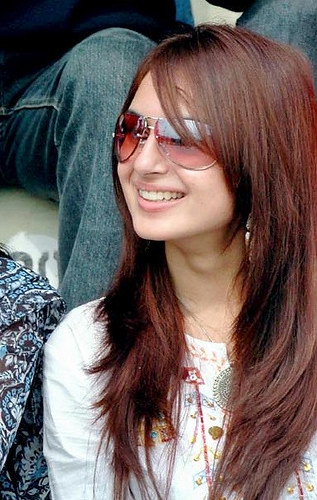Pakistani Girls Biography
Source(google.com.pk)
Aafia Siddiqui About this sound pronunciation (help·info) ah-fee-ah-see-dee-kee[needs IPA] (Urdu: عافیہ صدیقی; born March 2, 1972) is a Pakistani who studied neuroscience in the United States. She emigrated to the U.S. in 1990 and obtained a Ph.D. in 2001 from Brandeis University.[8] In early 2003, Siddiqui returned to Pakistan. In March 2003, she was named as a courier and financier for al-Qaida by Khalid Sheikh Muhammad and was placed on a "wanted for questioning" list by the FBI. She subsequently disappeared until she was arrested in Ghazni, Afghanistan, with documents and notes for making bombs plus containers of sodium cyanide. Siddiqui was indicted in New York federal district court in September 2008 on charges of attempted murder and assault stemming from an incident in an interview with U.S. authorities in Ghazni, charges which Siddiqui denied. After 18 months in detention, she was tried and convicted in early 2010 and sentenced to 86 years in prison. Throughout the trial, the Pakistani government supported Siddiqui, and her conviction resulted in some protests in Pakistan. Various media reports have also highlighted differences in how the case was portrayed in the U.S. and in Pakistan.
Siddiqui came to the U.S. on a student visa in 1990 for undergraduate and graduate education, and she eventually settled in Massachusetts and earned a Ph.D in neuroscience from Brandeis University in 2001.[8] A Muslim who had engaged in Islamic charity work,[3] Siddiqui returned to Pakistan in 2002, before disappearing with her three young children in March 2003, shortly after the arrest in Pakistan of her second husband's uncle, Khalid Sheikh Mohammed, the alleged chief planner of the September 11 attacks.[9][10][11] Khalid Mohammed reportedly mentioned Siddiqui's name while he was being interrogated,[12] and shortly thereafter, she was added to the FBI Seeking Information – War on Terrorism list.[11][13] In May 2004, the FBI named Siddiqui as one of its seven Most Wanted Terrorists.[11] Her whereabouts were reported to have been unknown for more than five years until she was arrested in July 2008 in Afghanistan.[9] Upon her arrest, the Afghan police said she was carrying in her purse handwritten notes and a computer thumb drive containing recipes for conventional bombs and weapons of mass destruction, instructions on how to make machines to shoot down U.S. drones, descriptions of New York City landmarks with references to a mass casualty attack, and two pounds of sodium cyanide in a glass jar.[14][15][16]
Siddiqui was shot and severely wounded at the police compound the following day. Her American interrogators said she grabbed a rifle from behind a curtain and began shooting at them.[17] Siddiqui’s own version was that she simply stood up to see who was on the other side of the curtain and startled the soldiers, one of whom then shot her.[18] She received medical attention for her wounds at Bagram Air Base and was flown to the U.S.[19] to be charged in a New York City federal court with attempted murder, and armed assault on U.S. officers and employees.[10][20] She denied the charges.[21] After receiving psychological evaluations and therapy, the judge declared her mentally fit to stand trial.[22][23] Siddiqui interrupted the trial proceedings with vocal outbursts and was ejected from the courtroom several times.[14] The jury convicted her of all the charges in February 2010.[17][24][25] The prosecution argued for a "terrorism enhancement" that would require a life term;[6] Siddiqui's lawyers requested a 12-year sentence, arguing that she was mentally ill.[26][27] The charges against her stemmed solely from the shooting, and Siddiqui was not charged with any terrorism-related offenses.[28][29]
Amnesty International monitored the trial for fairness.[30] Four British Parliamentarians called the trial a grave miscarriage of justice that violated the Sixth Amendment to the United States Constitution as well as the United States' obligations as a member of the United Nations, and demanded Siddiqui's release. In a letter to Barack Obama, they stated that there was a lack of scientific and forensic evidence tying Siddiqui to the weapon she allegedly fired.[31] Many of Siddiqui's supporters, including some international human rights organizations, claimed that Siddiqui was not an extremist and that she and her young children were illegally detained, interrogated and tortured by Pakistani intelligence, U.S. authorities, or both, during her five-year disappearance.[9] The U.S. and Pakistan governments have denied all such claims.[15][32]
The police superintendent of Sindh Province, Pakistan, said in a 2010 audio-recorded testimony that he "confirmed his personal involvement in arresting and abducting Siddiqui and her three small children in March 2003. He said that local Karachi authorities were involved, participating with Pakistani intelligence (ISI), CIA and FBI agents
Siddiqui was born in Karachi, Pakistan, to Muhammad Salay Siddiqui, a British-trained neurosurgeon, and Ismet (née Faroochi), an Islamic teacher, social worker, and charity volunteer.[11][35] She belongs to the Urdu-speaking community of Karachi. Her mother was prominent in political and religious circles and at one time a member of Pakistan's parliament.[36] Siddiqui is the youngest of three siblings.[11] Her sister, Fowzia, is a Harvard-trained neurologist who worked at Sinai Hospital in Baltimore[37] and taught at Johns Hopkins University before she returned to Pakistan.[38]
Siddiqui attended school in Zambia until the age of eight, and finished her primary and secondary schooling in Karachi.
Pakistani Girls Pictures

Pakistani Girls Pictures

Pakistani Girls Pictures

Pakistani Girls Pictures

Pakistani Girls Pictures

Pakistani Girls Pictures

Pakistani Girls Pictures

Pakistani Girls Pictures

Pakistani Girls Pictures

Pakistani Girls Pictures

No comments:
Post a Comment